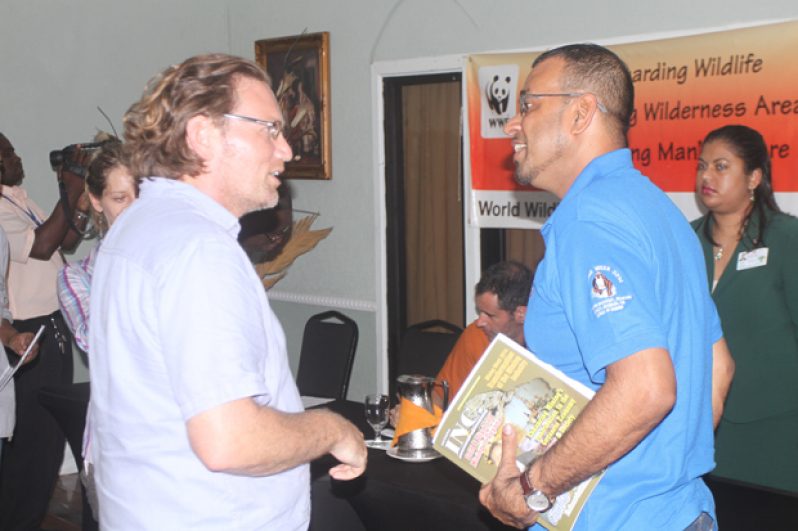PERFORMANCE assessments of deforestation rates for Guyana over the last three years reflect a rate of less than 0.1%.
This percentage clearly validates the point that, within the forest sector, there remains a high level of forest legality and minimal impact on deforestation and forest degradation, Minister of Natural Resources and Environment (MNR&E), Robert Persaud said yesterday.
He said: “We have seen recently in the press broad, baseless and uninformed statements made about negative impacts of forest activities on the forest. Given the performance assessments by a third party international auditor, following international guidance for such audits, these statements can be seen as unsubstantiated.”
“The allegations about mismanagement of the forests fall flat in the face of available evidence of an internationally credible third party audited system. The results are there for all to review,” the minister said.
He made the refutations to the allegations currently in circulation during the closing session of a South-South international exchange workshop on Community Measurement Reporting and Verification (CMRV), which was hosted by Guyana from August 22nd to 28th.
The CMRV system, it was explained, aims at developing and implementing a community-based process for buttressing the United Nations Collaborative Programme on Reducing Emissions from Deforestation and Forest Degradation in Developing Countries (REDD+)
REDD+ is a financial mechanism through which developing countries can sell the carbon stored in their forests to developed countries that need to offset their emissions.
By attaching financial value to carbon stored in forests, REDD+ intends to create an incentive for developing countries to better protect and manage their forests, while at the same time contributing to the global fight against climate change.
The South-South workshop had been organised through a collaboration of the World Wildlife Fund (WWF) Guianas with the WWFs Forest Carbon Programme (FCP), the Global Canopy Programme (GCP), and the Global Forest Observation Initiative’s Silva Carbon programme.
Held at the Roraima Arrowpoint Resort, the seven-day event had been attended by CMRV practitioners from several countries around the world, including Brazil, Costa Rica, Mexico, Peru, Ecuador, Colombia the Democratic Republic of the Congo, Indonesia, Nepal, the United States of America, Great Britain, Austria and the Netherlands.
The aim was to share lessons amongst MRV practitioners from around the world.
Guyana’s participants came from the Guyana Forestry Commission, WWF Guianas, the North Rupununi District Development Board (NRDDB) and Iwokrama.
WWF Guianas said that Guyana had been chosen as the host country for the workshop due to its leadership role as the first country in the world with a functioning national-scale MRV System, as well as pair of innovative CMRV projects in two indigenous communities.
One of these innovative CMRV projects in indigenous communities developed systems in the sixteen communities of North Rupununi through a collaboration with the UK-based GCP and the Iwokrama International Centre.
In the second project, the Wai Wai community of Masakenari, formerly known as Konashen, was recently trained by the NRDDB to develop their own CMRV capacity under a project initiated by WWF Guianas.
Both projects were funded by the Norwegian Agency for Development Cooperation, NORAD.
The closing session of the South-South international exchange workshop on CMRV was held at the Roraima Duke Lodge in Kingston, Georgetown. The closing programme included presentations by Dr Patrick Williams; Head of the WWF Guianas, based in Guyana; Mr Naikoa Amuchastegui, MRV Coordinator, WWF International Forests and Climate Program; Mr. Y. Kurniawan, WWF Forest Management Coordinator, Indonesia; and Mr Jon Parsons, Technical Lead GCP.
In his remarks, Minister Persaud said that the MRVS at national and community level are essential aspects of Guyana’s Low Carbon Development Strategy.
He said the system introduced in 2009/2010 is the first national scale system that is developed using high resolution satellite imagery at 5-metre resolution.
The national MRVS, he stressed, has allowed Guyana to monitor both deforestation and forest degradation aspects of forest carbon emissions impacts annually.
It has been independently verified every year for the past three years by a third party international auditor, following international guidance for such audits.
All the results are made public.
He stressed: “Guyana now offers to the world a global model on how routine MRVS can be implemented in a robust, transparent and replicable manner. We are now able to report on national level deforestation and forest degradation in keeping with international best practice.
“The results of the MRVS therefore validate the point that within the forest sector there remains a high level of forest legality and minimal impact on deforestation and forest degradation.
Minister Persaud said: “Guyana stands on firm ground in asserting that our forests are well managed, have consistently reflected a low rate of deforestation of less than 0.1%, and have reported a verified low rate of illegality.”
With respect to CMRVs, he said that these have been identified as a key action under the LCDS.
Since 2012, the GFC has been working with Iwokrama, and the NRDDB in successfully installing a CMRV in Annai, North Rupununi.
With the support of WWF, work has also been done to develop a CMRV in the community-owned conservation area (COCA) in Konashen, Deep South Rupununi, an area that is considering protected areas status.
Written By Clifford Stanley




.png)









